Please note: As an Amazon Associate I earn from qualifying purchases. I also work with other affiliate partners and may be compensated from the links below. Details here.
3 Best Cameras for Street Photography 2021: Document Everyday Life As You See It!
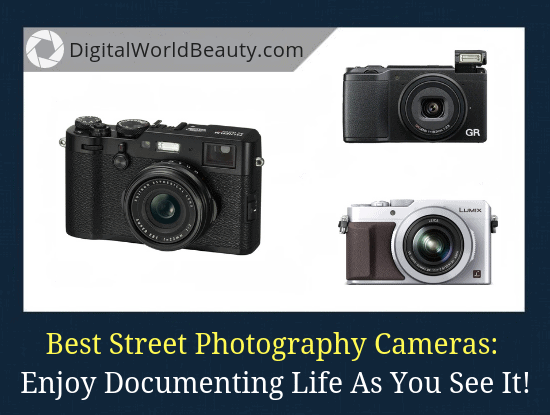
Without a doubt:
Street (candid) photography is a beautiful form of art, with the element of spontaneity.
And it certainly is a great way to unleash your creativity.
Now…
If you want to document everyday life as you see it, I created a list of the 3 best cameras for street photography in 2021 (across various budgets).
When choosing which cameras to put in my top 3 list, the following were taken into account:
- experts’ recommendations
- personal experience
- user reviews
- certain features (size and IQ)
- price
Without further ado, here’s what to expect in this post:
3 Best Street Photography Cameras (2021)
- Fujifilm X100F – Best large sensor compact for street photography in 2021.
- Ricoh GR II – Best budget street camera 2021. Legendary among street shooters.
- Panasonic LX100 – One of the great photography deals available right now.
Look…
In my opinion, there are 3 main things you need out of your street photography camera:
- good image quality
- easy to use (no complicated settings)
- light weight and compactness… in this case size matters 😉
Alright, let’s get started.
(Warning: This post is LENGTHY but I do answer a lot of FAQs. So grab a coffee!)
Best Camera for Street Photography Today
Fujifilm X100F
- Type: Large sensor compact
- Weight: 469 g
- Sensor size: APS-C (23.6 x 15.6 mm)
- Resolution: 24 MP
- LCD: Fixed
- Touchscreen: None
- Weather resistant: No
- ISO: Auto, 200-12800 (expands to 100-51200)
Truth is:
The features that Fuji X100F offers makes it one of the best large sensor compact cameras on the market.
Now…
If you specialize in documentary/street photography, then this Fuji certainly is a solid option for you.
The features you’ll love:
- lightweight and compactness,
- unique hybrid viewfinder,
- amazing image quality (even at high ISO),
- great background blur and a slightly wide focal length,
- full HD video at 60 fps,
… Just to name a few.
A lot of people also love the retro design (I know I do!).
==> Check price & availability on Amazon.
==> Check price & availability on B&H Photo Video.
Fujifilm X100F for Street Shooters (Video Review)
Check out Pablo’s video review below as well as some images made with X100F. You’ll also understand why this large sensor compact is a solid option for street photographers.
Fujifilm X100F: FAQ
Q: What’s so special about its viewfinder?
Earlier I mentioned that Fujifilm X100F offers a unique hybrid viewfinder. What it means is that it can work both in OVF and EVF (at the same time).
And it’s made easy:
Basically you have a switch and you turn the Hybrid OVF into a full fledged EVF.

Now…
The electronic viewfinder (EVF):
- Displays the image with the same brightness and color that you’ll see on the photo.
- Keep in mind: There’s a possibility of a bit of digital noise when shooting in low light.
The optical viewfinder (OVF):
- Provides a bright and clear image in any shooting conditions, though it’s impossible to track the correct exposure and white balance on it.
Q: What can you say about the lens?
Camera’s main feature is its 35 mm equiv. f/2 fixed lens, which has:
- great rendering,
- insane macro ability,
- amazing sharpness,
- smooth background blur (bokeh),
… And it’s awesome.
And guess what?
This focal length is sort of a benchmark for street and documentary photography because 35mm focal length most closely resemble the perspective of the human eye.
Now:
The fixed lens might upset some photographers, but for others it might be the decisive factor because they don’t have to worry about the dust on the sensor or about buying different lenses.
As for zooming in, you’ll just have to do it with your feet 🙂
Bottom line:
Fuji X100F is one of the best cameras for travel and street photography right now.
Q: How’s the image quality?
Honestly, it’s fabulous.
You’ll be impressed by the level of quality that this “pancake” lens produces, be it the sharpness, the bokeh, the saturations or anything else.
And yes, the images are great both in JPEG and RAW format.
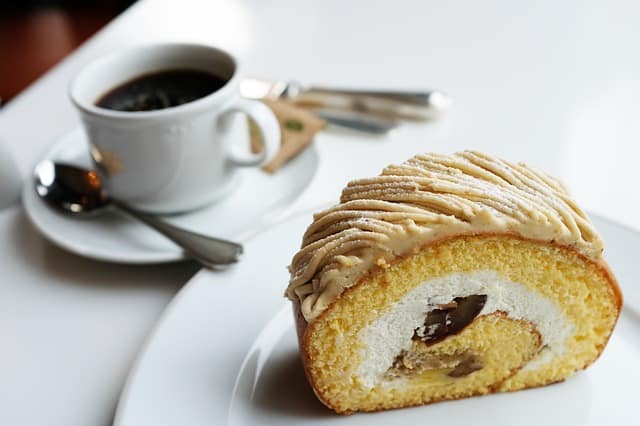
It gets better:
This baby will produce quality photos in any lighting conditions (which is one of the main reasons I listed it as my #1 choice vs. Ricoh GR II).
Point is…
All the hype about its IQ is justified.
Q: How’s the autofocus in Fuji X100F?
Without doubt:
The start up time and autofocus are a lot better than in the previous camera models.
You’ll have 49 phase detect AF points and 325 focus points in total. For quick selection of AF points, there’s a joystick.
(Choosing the 91 point option is the sweet spot, IMHO.)
In my experience, the autofocus in X100F is a bit slower than in Fuji X-T2 (despite having the same sensor and processor) but it’s still great.
And if you’re used to Ricoh GR, you’ll certainly feel the difference (it’s a lot faster on X100F).
Anyway…
AF is quick, decisive and fairly quiet. You definitely won’t miss that awesome shot because of AF.
Important:
Some say that there are autofocus misses sometimes but I think it has to do with the preview of the image. Try turning it off (Image Preview —> OFF) if you encounter this issue.
Q: What about its low-light performance?
As I mentioned earlier, X100F has a great low light performance.
(Usable at 12800 ISO units.)
So…
If you’re doubting between this compact vs. Ricoh GR II for street photography during evening hours, then go for the former.
Anyway:
I think many will agree with me here that Fujifilm X100F is the best camera for night street photography right now.
Q: How portable is it?
When it comes to size and weight, you’ll love it. I mean you can carry it around for hours and hours.
Also easily pocketable in a jacket pocket.
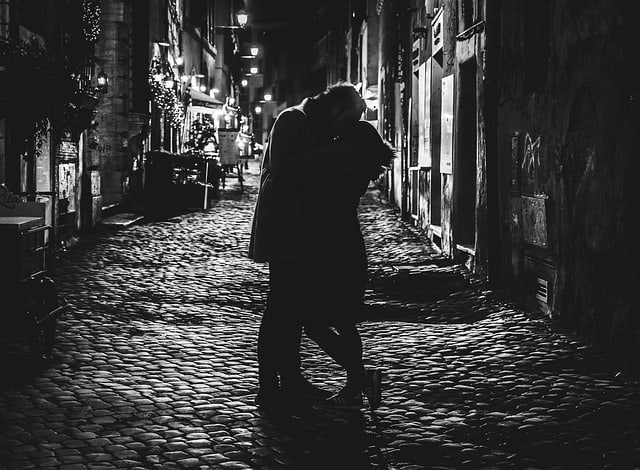
Now…
If you want a super light and small compact, Ricoh GR II might be a better option for you.
Q: Is it weather-sealed?
Unfortunately, it’s not.
Yeah, I know it’d be great to have it environmentally sealed given that it’s a street photography camera but I guess you’ll have to be careful using it on a rainy day.
Alternative option:
Fuji X-Pro 2 with the 23 mm f/2 lens has that advantage but it’ll definitely be more of a hassle to carry it around.
A lot of travel and street photographers love this Fuji.
Q: How’s the battery life?
X100F has NP-126S battery (shared with X-T2/X-Pro2) and it’s pretty good.
But I always recommend to have a spare battery handy, especially if you love walking around for hours.
Q: What are this camera’s serious drawbacks?
Like anything else in this world, X100F isn’t perfect.
The main drawback, in my opinion, is its fixed screen.
I mean for street and travel photographers, having an articulated screen sometimes is a big deal.
Here’s the thing:
We don’t always use the viewfinder, but also shoot from the hip, or perhaps taking shots at ground level.
And this is when the fixed LCD might start to annoy you.
And still…
This camera is great.
Note:
It’s pretty expensive. So, if you’re on a small budget, consider Ricoh GR II instead.
Q: Fujifilm X100F vs. Ricoh GR II for street photography?
While it was super hard for me to choose which of the two to place as my #1 choice, I went with X100F because of it’s great low-light performance.
But Ricoh GR II certainly is a legendary camera among street photographers for many reasons.
Bottom line:
If you can’t afford Fuji, then I absolutely recommend going with Ricoh. (Scroll down to read more about it).
Fujifilm X100F for Street Photography (2021)
X100F certainly is my #1 pick and if you ever hold it in your hand, you’ll understand why.
Remember this:
It offers a 23 mm lens (35 mm equiv.) which is great for street photography but isn’t wide enough for architecture (for example).
And you’d have to “zoom in” with your own feet.
Either way…
X100F is one of the best large sensor cameras with outstanding image quality.
If you:
- love shooting street photos,
- want a camera with great low light performance, and,
- don’t want any hassle with the interchangeable lenses,
… then this Fuji is a great option.
Best Budget Street Photography Camera 2021
Ricoh GR II
- Type: Large sensor compact
- Weight: 251 g
- Sensor size: APS-C (23.7 x 15.7 mm)
- Resolution: 16 MP
- LCD: Fixed
- Touchscreen: No
- Weather resistant: No
- ISO: Auto, 100-25600
Truth is:
Ricoh GR II has been sort of a legendary compact camera for street photographers for years.
(And it still is).
There are a number of reasons why you should consider this camera.
Specifically:
- fast autofocus,
- great image quality/sharpness,
- small, light, pocketable, inconspicuous camera,
- high ISO performance and amazing B&W images,
- it’s easy to use, all controls are where you expect them to be.
Best of all?
It’s one of the best budget street photography cameras right now.
(Often under $600 on Amazon).
==> Check price & availability on Amazon.
==> Check price & availability on B&H Photo Video.
Ricoh GR II for Street Photography (Video Review)
The video below will give you 5 reasons on why it’s a great camera for this genre.
Ricoh GR II Street Camera: FAQ
Q: What can you say about its lens?
First of all, Ricoh GR II has a fixed 28 mm equiv. f/2.8 lens.
(Since it’s a fix, there’s no optical zoom and you’ll have to zoom with your feet.)
When shooting wide open at f/2.8, you’ll have a nice bokeh effect.
It also has a built-in ND filter that can be activated, deactivated, or switched to Auto mode in the menu. (It allows you to reduce the amount of light when shooting very bright scenes.)
Point is:
This camera has a nice sharp prime lens which gives great image quality and fantastic black & white photos.
Q: How’s the image quality?
Images are ridiculously sharp.
If you are a fan of street photography in black & white, you’ll especially love Ricoh GR II.
Now…
For most users, JPEG format will be enough. But if you need more flexibility and versatility, if you want to “squeeze” your photo as much as possible, then you can shoot in RAW.
(Keep in mind that the built-in photo filters do not apply to RAW images.)
Another thing:
It is also worth noting that the noise reduction function in the camera works quite well. Yes, it softens the image a bit, but it’s still very sharp.
Q: How’s the focus system?
While its auto-focus is not as fast as in its Sony competitors, it’s still pretty decent/accurate.
Useful focusing modes:
- Infinity, and,
- Snap focus.
Infinity mode allows you not to think about focusing at all, just point the camera at the object and press the button (you just need to take into account the minimum distance).
Snap focus mode allows you to determine the focus distance in advance and the camera will focus on this distance.
See image below:
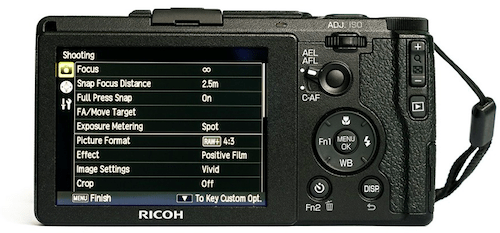
(Snap focus mode makes focusing easier.)
Q: What about its low-light performance?
I’ll be honest:
If you’re looking for a little monster in low-light conditions, this isn’t your camera.
I mean it’s OK but you might experience digital noise even at low ISO.
Q: How portable is it?
Without a doubt, Ricoh GR II is one of the lightest cameras on the market.
If your jeans aren’t tight, you’ll be able to fit it in your pocket.
Q: Is it weather-sealed?
Nope.
Considering that this compact was specifically designed for street shooting, it makes me wonder why it isn’t weather-resistant.
*face palm emoji*
Q: How’s the battery life?
Honestly, it’s average.
I suggest you have a spare DB-65 battery handy.
Q: What are this camera’s serious drawbacks?
Well…
If we’re honest about it, I will mention a few:
- no viewfinder,
- fixed screen,
- poor video capabilities,
- average low light performance.
Keep in mind though, that Ricoh’s “competitors” might not have all these options too.
Let me add this:
Despite the aforementioned drawbacks, Ricoh GR II is a great choice for travel shooting.
And it certainly is one of the best cameras for street photos currently available on the market.
Q: Fujifilm X100F vs. Ricoh GR II for street photography?
Truth is:
Fujifilm X100F and Ricoh GR II are the most highly rated large sensor cameras among street photographers.
Here are my thoughts to help you make a decision.
So…
Choose Ricoh GR II if you:
- are on a smaller budget (this camera costs less than $500),
- love B&W shots,
- want lighter/pocketable/more conspicuous camera.
- if street photography is your main genre.
Choose Fujifilm X100F if you:
- have the means to spend more than $500,
- often shoot in low-light conditions,
- want better image quality overall,
- need a camera not only for street photos, but travel and anything else.
IMHO.
If you know what you need in your camera, making a choice will be easier.
Best Budget Street Photography Camera in 2021
Here’s the deal:
If you’ve never had experience with Ricoh cameras, you’re in for a pleasant surprise.
This rather modest-looking camera offers a lot, especially for street photographers:
- it’s highly responsive,
- produces great coloured and B&W images,
- and is very easy to use.
Rich customization options let you customize the camera to your taste and get real pleasure from street shooting.
Truth is…
Ricoh GR II is one of the best budget compact cameras with APS-C sensor, that’s always in your pocket.
Top Rated Point & Shoot Camera for Street Photos
Panasonic LX100
- Type: Large sensor compact
- Weight: 393 g
- Sensor size: MFT (17.3 x 13 mm)
- Resolution: 13 MP
- LCD: Fixed
- Touchscreen: No
- Weather resistant: No
- ISO: Auto, 200-25600 (expands to 100-25600)
Here’s the thing:
Every street photographer’s dream is to have a small compact camera with a large sensor and a good zoom lens that can produce masterpiece photos anytime, anywhere.
One of the cameras that gets close to it is Panasonic Lumix LX100.
If we consider all things combined such as…
- micro four-thirds sensor,
- its price tag,
- the high quality of images and videos,
- versatility,
- camera’s compactness,
- its very nice time lapse settings,
… It then can be argued that Panasonic Lumix LX100 with a fast f/1.7–2.8, 24–75mm zoom lens is one of the best photography deals you’ll find on the market right now.
I will say more:
Its fast Leica DC zoom lens and a MFT sensor are a steal.
Why?
For comparison purposes, the price of Canon 24-70 mm f/2.8 lens ALONE is twice as much as the entire LX100 camera.
Now…
Lumix LX100 has a rather challenging menu system so just give it some time and eventually it’ll really grow on you.
And if you ARE familiar with manual controls, you’ll see just how amazing this compact is.
==> Check the exact price on Amazon.
==> Check price & availability on B&H Photo Video.
Awesome for Travel Photography As Well (Video)
Truth is:
This camera is awesome only for street photos but also for travel and daily photography.
Moritz Janisch, a filmmaker from Germany, shared his experience with LX100 and why it’s his favourite 4K travel camera now. Let’s have a watch:
FAQ About Lumix LX100 for Street Photography
Q: What can you say about its lens?
The most important feature of Lumix LX100 is its Leica lens.
Unlike other large sensor compacts, this one managed to place an optical system with 3.1x zoom and high aperture (f/1.7-2.8) while still keeping its modest dimensions.
I won’t get into all the technical details but the construction of the lens sure is complicated.
Point is…
The way this lens was built ensured that in such a small camera you get:
- shallow depth-of-field,
- low noise level, and,
- a nice bokeh effect.
I’ll say this:
Just a lens alone is worth the money.
Q: How’s the image quality?
Many will agree with me that the IQ is very nice, especially considering that it’s a point-and-shoot camera.
(Even in low light situations).
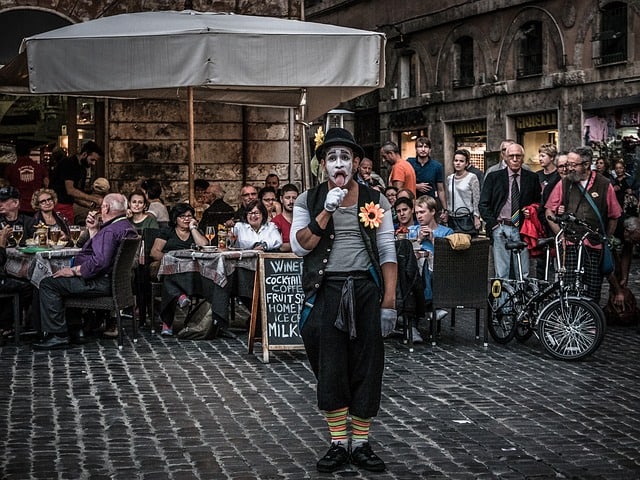
Now…
You should keep in mind that it’s still a 4/3 sensor camera, so it can’t be pushed too much. I’d say you can go up to ISO 3200 without seeing much noise.
In any case, I think it’s the best street photography camera under $1000 that you can find right now.
Q: How’s the focus system?
Here’s the thing:
Speed and accuracy of autofocus is something that Panasonic cameras can usually boast about.
(Indeed, the autofocus is fast in both mirrorless and compact cameras.)
So, LX100 point-and-shooter showed an amazing 0.14 seconds when testing according to CIPA standards.
Now…
This number would be normal for a compact camera with a small sensor but Lumix LX100 has a larger (MFT) sensor, which means that the depth of field is smaller and so the adjustment needs to be an accurate one.
Point is:
While you shouldn’t expect the AF accuracy be on the par with high-end full-frame cameras, it’s still pretty good.
Note:
If you like video-shooting, you might not be as happy with the AF tracking in video mode.
Q: What about its low-light performance?
Let’s be straight:
Not only speed is important, but also the ability to focus in difficult conditions, particularly in low light, especially when it comes to compacts.
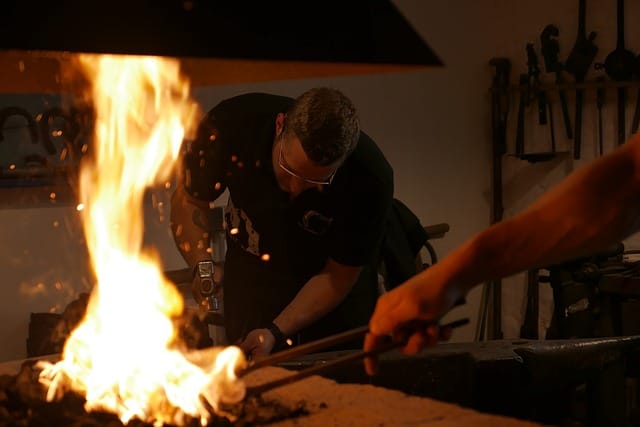
The f/1.7 Leica lens helps to have good low-light shots but as I said earlier, since it’s a micro four-thirds sensor it can’t be pushed too much.
You might see some loss in detail at high ISO if you zoom in (not as noticeable at low ISO).
Q: How portable is it?
It certainly is “portable” but I wouldn’t say it’s “pocketable” since it might be a little too large for your pockets.
Though if you wear cargo pants, it’ll fit.
(Sony RX100 IV, for example, is more pocketable.)
Q: Is it weather-sealed?
It’s not.
But then again, neither are it’s competitors (Fujifilm X100F and Ricoh GR II).
Q: How’s the battery life?
You can shoot about 300-400 pictures or record approximately 150 minutes of video (may last up to 3 days).
If you use the flash and a viewfinder, it’ll have a significant impact on the battery. Using LCD screen doesn’t drain it as much.
Suggestion:
Just as with most compact cameras, I highly recommend that you have a spare battery handy.
Q: What are this camera’s serious drawbacks?
I will mention a few flaws you should know about.
- Slow start up time when you turn it on, so you might potentially miss a moment.
- Might encounter errors of auto exposure in artificial lighting.
- No external mic jack.
Now…
I also want to address the important question on dust issue.
Q: How common is the “dust on sensor” problem?
Here’s the thing:
You might be OK with anything else about this camera but now you’re scared to invest your money on a “risky investment” because of its potential dust sensor you’ve read online.
First of all, many photographers actually don’t seem to have this issue, especially if they are careful.
Here’s what Dan has to share about this:

Note that his comment was recent (on March 23, 2018).
So, why does this happen?
The thing is that this camera isn’t sealed and and what happens is that the retractable lens sucks the dust in right through the sensor.
Suggestion:
Try not to expose your camera in an environment where there’s a lot of dust. (Or use the zoom function for that matter).
Funny thing is that it isn’t much of an issue with the lens wide open, you’ll realize the problem when stopping down. (For example, when shooting bright scenes at f/16.)
What to do if you DID end up getting dust?
The good news is that Panasonic can clean your sensor for free (within warranty).
Generally speaking, they do it fast and offer a great pickup and dropoff service.
So…
I hope this answers your concerns.
Great 4K Compact for Most Photography Genres
Truth is…
Panasonic Lumix LX100 is great not only for street photos but also:
- food photography,
- landscapes,
- family vacation pics, and,
- also is amazing for macro photography,
… Just to name a few.
Point is:
It has a highly versatile lens and there’s really very little this point-and-shooter can’t do.
And if you’re looking for 1 travel camera that…
- doesn’t include interchangeable lenses,
- works for most situations,
- and is affordable enough,
…then LX100 is for you.
In any case, this Panasonic might be one of the best photography deals on the market right now.
General Questions About Street Photography
Q: What cameras do street photographers use?
Ricoh II is THE camera, it’s pretty much legendary among street photographers. Another great street camera is Fujifilm X100F. (Both reviews are included in this article).
Q: What is the best focal length for street photography?
Ideally you’d want a 35mm focal length. It is sort of a benchmark for street and documentary photography because this focal length closely resembles the perspective of human vision.
Q: What is the best budget street photography camera in 2021?
Even though the Ricoh GR III is already out on the market, if you’re looking for the best BUDGET camera for street photos, then consider the Ricoh GR II model.
Q: Is a 50mm lens good for street photography?
The 50mm prime lens is one that every photographer should have. Yes, it is possible to use it but the 35mm focal length is perhaps the best lens for street photography because it comes close to our human vision.
Q: What is the best setting for street photography?
Okay, so you already have the best camera for this genre. The next problem you’ll encounter is how do you make the most out of your gear when you are on the field.
Well, every photographer has his own shooting style and techniques. This is true especially when it comes to settings. It actually depends on how you want your photos to look in the end.
Firstly, you need to determine how you want your subjects to appear in your imagery. Do you want them to be seen close up or do you want to see them further away from you? These considerations will determine where you need to set your focus points.
Next setting you need to pay attention to is the aperture. For this genre, you might want to stick with setting your camera to AV or also known as aperture-priority mode. This will allow you to manually set the aperture to ensure you get the exact exposure you need.
The rest is up to you.
Q: Do you need permission from subjects for this genre?
This is quite a controversial topic for debate amongst people in this field and non-photography folks. Sometimes, street photographers are branded as unethical because they take photos of strangers without their express permission.
But, does this really mean it is unethical for a photographer to do so?
Well, as far as I know, it’s legal to take pictures of anything or anyone as long as they are on a public property (and of course in conformity with community standards). But this might differ from place to place. There are certain countries where it is illegal to take stranger’s pictures without permission, even if it’s in a public setting.
The best thing you can do in this situation is to ask for permission. And if they say yes, then you are all set. The only problem with this set-up though is that it takes away that “candid” aura which street photography is known for.
No matter how much you tell your subjects to act as naturally as possible, the results will be different compared to when they don’t know they are being photographed. Sometimes, it will even look too staged. But that’s the price you have to pay to take their pictures legally.
But if you want to go for street photos that are not staged, then you can continue to do so. Just always keep in mind the laws of that particular place so you won’t have any problems afterwards.
Q: What makes street photography so great?
There’s actually so much beauty in this genre. Through it, you get to have a peek on the daily normal (and realest) lives of people. It gives you some sense of connectedness to the rest of the world.
If you see people doing mundane things, there’s a tendency you will reflect on your own life and see the similarities, or see the great contrast between you and the rest of the world.
Choosing Your Camera for Street Photos in 2021
So:
In here, I’ve listed the 3 very best street cameras right now that you’ll love if you are a travel/documentary/street photographer.
I chose these 3 mainly because they:
- are compact,
- have large sensors, fixed lenses and great AF speed,
- offer awesome image quality,
- are portable (and even pocketable), and,
- easy to work with.
Just to name a few.
(I will also keep updating this article with more options for you.)
Now…
I’d like to hear from YOU:
- Is street photography your main genre?
- Which camera would you choose from this list and why?
- If you are experienced in street shooting, which compact would YOU recommend?
As always, any questions, suggestions and/or concerns are welcome in the comments!
Click here to jump straight to comment form.
Sharing is caring!
About Author
Zarina
Founder & content creator at Digital World Beauty. My main objective here is to create a valuable resource for photography enthusiasts with honest tech reviews, course recommendations, and how-to tutorials.






Hey there and thanks for all of the information you provided here. I have to be honest, I don’t know a whole lot about compacts as I’m looking for a camera for my wife as a Christmas gift.
She is getting into photography and I think “street photography” is exactly the style she is into. So thanks for writing this. I’m probably just going to take you up on the Fujifilm X100f.
I’m assuming that this camera is going to be one of the better options for movement right? That’s the main thing I’m really looking for as anything that can reduce blurriness in that regard would be ideal.
At the end of the day, is there a better camera to avoid blurry photos from movement or would the Fujifilm X100f be the best option?
Hi Daniel,
Some might wonder if having no image stabilization might be an issue in X100F (that is getting blurriness in your photos as a result of shaking/movement) but I will say this:
X100F has great ISO performance and a 23mm lens, so you won’t need OIS most of the time.
Point is…
Lack of image stabilization will NOT affect your image quality.
Last thing.
If your shutter speed is faster than 1/30, then you’ll be fine. Just tell your wife to configure auto ISO and set minimum shutter to 1/50 or 1/60.
I think the last part will make more sense to your wife if you’re not familiar with photography but I thought I’d say it anyway, so you keep it in mind, if anything.
Bottom line:
Fuji X100F is an EXCELLENT choice as a Christmas gift and I’m sure your wife will love. Even if it’s not street photography, the camera is still light and compact enough during travels, for example.
Hope this helps!
Awesome information on street cameras.
I don’t know all that much about photography but I do know that MP (megapixels) does matter for the picture quality, though.
I noticed that the Fujifilm X100F has 24 MP. The Ricoh GR II has 16 MP and the Panasonic LX100 has 13 MP.
I know the Fijifilm X100F is about two times as much as the other two, though. However, how much of a difference in picture quality are you going to notice between 24 MP and 16 and 13 MP?
Also, is it even possible to get a better lens for the Ricoh or Panasonic one to give it better picture quality?
Hi Garen,
You’re right, more megapixel count means better image quality. For example, if you make large prints, MP will matter a lot. (Or if you want to crop your image and want to have a good amount of detail.)
As a rule, more MP means higher resolution photos, though the actual optical resolution is given by the combination of lens and sensor. This means that if your lens doesn’t resolve as good as your sensor, increasing the amount of pixels won’t change anything.
And without a doubt, Fuji produces richer photos. Ricoh is awesome for black and white photography fans.
I will say this:
Fuji X100F wins in about everything. And unlike Ricoh GR II you’ll be able to shoot more than just strictly narrow streets, I mean it’s 35mm lens is more versatile. BUT Fuji isn’t really pocketable (jacket pocket will work), so you should keep this in mind.
To answer your last question:
All 3 cameras have fixed lenses, so you won’t be able to get a better lens even if you wanted to. In my experience, fixed lenses remove all the hassle of constantly changing them when you shoot street photography.
I hope this helps!
I still feel a bit lost on how do we choose the right camera for street photography? Which camera is the best? Also I’d like to hear from you what other camera options are there for street photos?
Looking forward to your response.
Hi Coco,
Well, the short answer is that any camera would work. It’s important to get started with photography, whatever gear you have. Or you can borrow from friends and gain that necessary experience before buying your own.
The longer answer:
Choosing a camera includes several important points. First of all, you need to look at the characteristics of its sensor and the (fix) lens of a camera.
Secondly, its physical characteristics like: size, noise, and convenience (it is an individual parameter and depends largely on habit).
Of course, this is not a complete list, but I would start with this.
Now, if this is your first camera, then it will be difficult for you to judge the quality of the sensor and lens. In this case, it’s worth relying on the opinion of those who have already used this camera – forums, video reviews, etc.
There’s also personal likes involved. For example, for some street photographers it’s important to have a camera that works quietly, others don’t really care. Same with the size/compactness (especially considering how large/small your hands are).
The good news is that if you feel like whatever product you purchased doesn’t suit you, you can always return it. Amazon, for example, offers 30-45 days for return.
(However, do check with each individual seller for their return policy.)
Finally, other compact cameras you can look into for street shooting are:
– Fuji X-E3
– Olympus E-M10
– Olympus Pen-F
– Sony RX100 II/III/IV
– Canon M50 (awesome camera, especially for videos!!
==> Check out glowing reviews on Amazon)
Thanks for asking these questions, Coco.
I’ll take the time to update my list with more options this year.